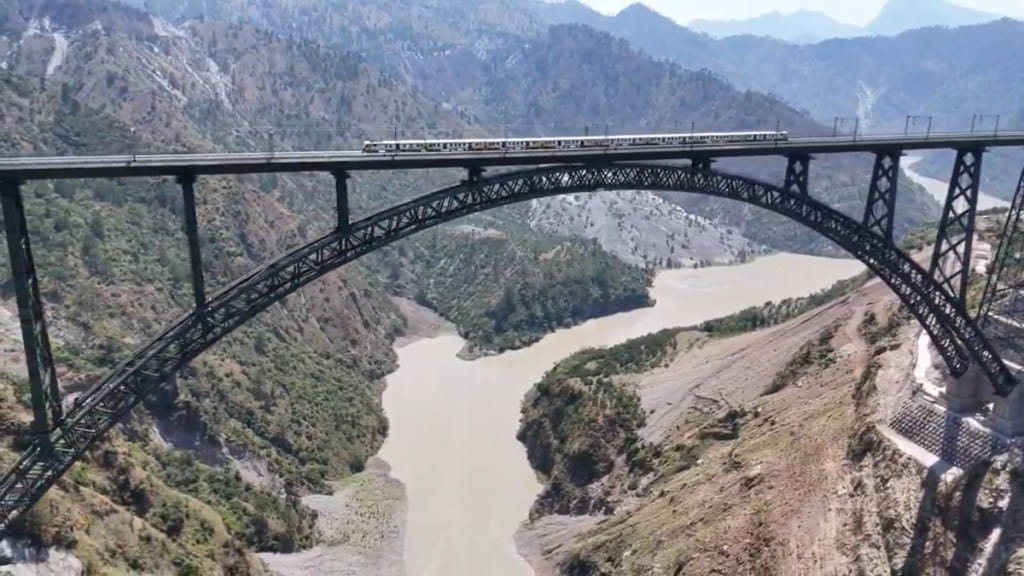Jammu and Kashmir: In just three days, Prime Minister Narendra Modi will travel to Jammu and Kashmir to inaugurate two momentous projects: the world’s highest railway bridge over the Chenab River and the new Vande Bharat express connecting Katra to Srinagar. Coming at a time when Kashmir is reeling from the tragic Pahalgam terror attack, these developments are more than just infrastructure—they stand as symbols of resilience, hope, and progress, exactly what the Valley needs right now.
What do we know about the Chenab Railway Bridge?
The Chenab Railway Bridge, standing 359 metres above the riverbed, towers 35 metres above the Eiffel Tower and is nearly five times taller than Delhi’s Qutub Minar. With a length of 1.31 km and built using 28,660 megatonnes of steel, this bridge is now officially the highest railway bridge in the world.
Part of the Udhampur-Srinagar-Baramulla Rail Link (USBRL), the bridge took over two decades to complete and is touted as one of the most challenging civil engineering feats in Indian Railways’ history. Constructed in the treacherous terrain of the Reasi district in Jammu and Kashmir, the bridge had to be engineered to withstand high-speed winds of up to 266 km/h, sub-zero temperatures, and even high-intensity earthquakes.
#WATCH | Prime Minister Narendra Modi to inaugurate the Chenab Bridge on 6th June. This is the world's highest railway bridge located in Jammu and Kashmir. The bridge is a part of the Udhampur-Srinagar-Baramulla Railway Link, a 272-kilometre-long project. pic.twitter.com/ofT67aJIFp
— ANI (@ANI) June 4, 2025
Built by a consortium of Afcons Infrastructure (India), VSL India, and South Korea’s Ultra Construction, the bridge is a steel arch wonder designed by Canadian firm WSP. The structure’s resilience is such that it remains operational even if one of its piers is compromised—a testament to both innovation and foresight.
Why is the Chenab bridge necessary?
Along with the Chenab bridge, the Katra-Srinagar Vande Bharat Express will also be inaugurated. This new service could prove transformative for Kashmir’s tourism sector, which has taken a hit following the brutal April 22 terror attack in Pahalgam that killed 26 people, including 25 tourists. The Valley, which had been experiencing a tourism renaissance, saw a sudden drop in footfall. Locals protested the attack, desperate to not let terrorism derail their journey to normalcy.
The Vande Bharat service is equipped with cutting-edge technology to operate in harsh winter conditions. It includes silicone heating pads to prevent freezing and sensors to ensure uninterrupted power supply in sub-zero temperatures. Its introduction promises to offer safe, fast, and comfortable travel to a region that is often cut off during winter due to snowfall and landslides.
Strategic and economic significance
The USBRL project, of which the Chenab bridge is a part, spans 272 km and has required an investment of over Rs 42,000 crore. It includes 943 bridges and 36 major tunnels, including India’s longest railway tunnel—T-50, which stretches 12.77 km. This rail line connects the Kashmir Valley to the rest of India, not just physically, but economically and socially as well.
History in the making… Just 3 days to go!
— Dr Jitendra Singh (@DrJitendraSingh) June 3, 2025
The mighty #ChenabBridge, the world’s highest railway bridge, stands tall in #JammuandKashmir.
Part of the Udhampur-Srinagar-Baramulla Railway Link (USBRL). Built to withstand nature’s toughest tests.
PM Sh @narendramodi to… pic.twitter.com/EQnC0m1per
For traders, especially apple growers and artisans, the railway will enable quick transportation of goods to key markets in Delhi and beyond, cutting down delivery times to a single day. For the average Kashmiri, it means better access to healthcare, essential supplies, and economic opportunities year-round.
This inauguration is about more than steel and trains. It is a political and emotional statement: India is committed to Kashmir’s development, undeterred by terror. Originally scheduled for April 19, the inauguration was postponed due to the Pahalgam tragedy. Now, less than two months later, the Modi government’s decision to go ahead with the launch sends a clear signal—development will not be held hostage by violence.
The vision of a direct rail link to the Kashmir Valley dates back to the 1970s. Now, after decades of delay, it is finally coming to fruition.


